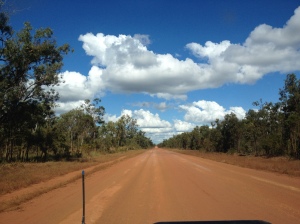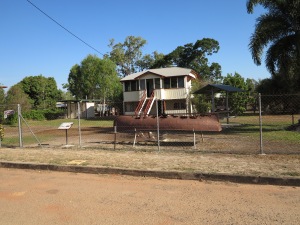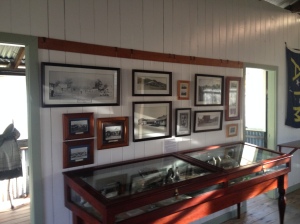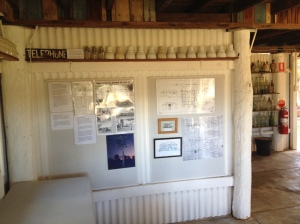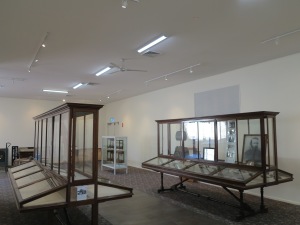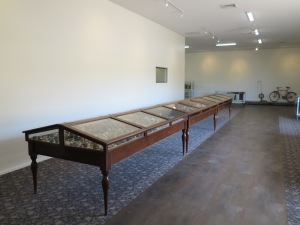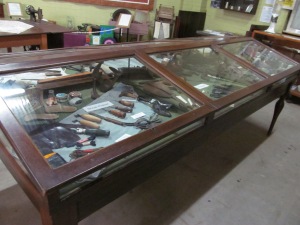Blog Archives
Preserving Vera’s gift: Work begins on the Endeavour River Series of botanical illustrations
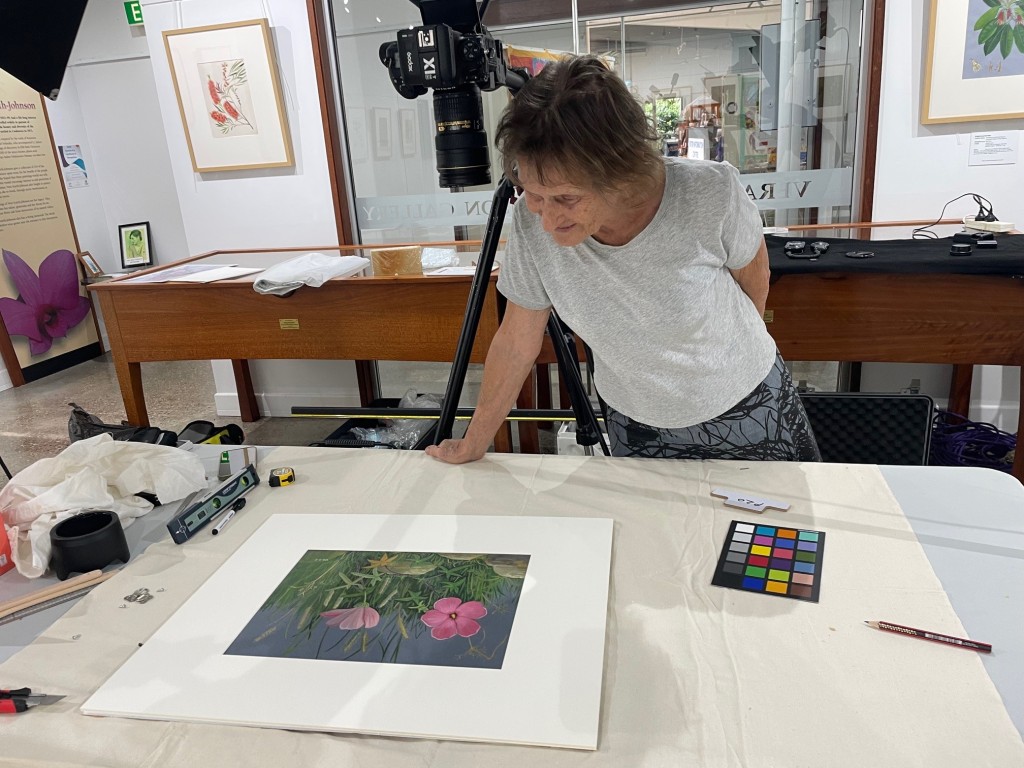
At the end of last year, the Vera Scarth Johnson Association approached me for advice about collection preservation and updating their gallery. Following the Association’s successful application to the Copland Foundation, Cairns-based museum worker and photographer, Michael Marzik, and I are now in the process of undertaking a two staged project to reinvigorate collection management and preservation, and refresh the gallery interpretation.
Vera’s gift
Vera was a remarkable woman. Between 1972 and 1999, Cooktown resident Vera Scarth-Johnson OAM created over 150 botanical illustrations as part of her ‘Endeavour River Series.’ Inspired by the natural environment, the botanical works of Joseph Banks and Daniel Solander and an interest in their Guugu Yimithir language names and usage, her quest to record different species in the Endeavour River Valley ended only when Parkinson’s disease prevented her from continuing.
In 1990, Vera gifted the Endeavour River Series of illustrations to the people of Cooktown in 1990. She hoped it would enrich people’s appreciation of Whalaumbaal – the Endeavour River region and inspire them to preserve it. The works reveals her lifelong passion for native wildflowers, their cultural and scientific use and her commitment to conservation.
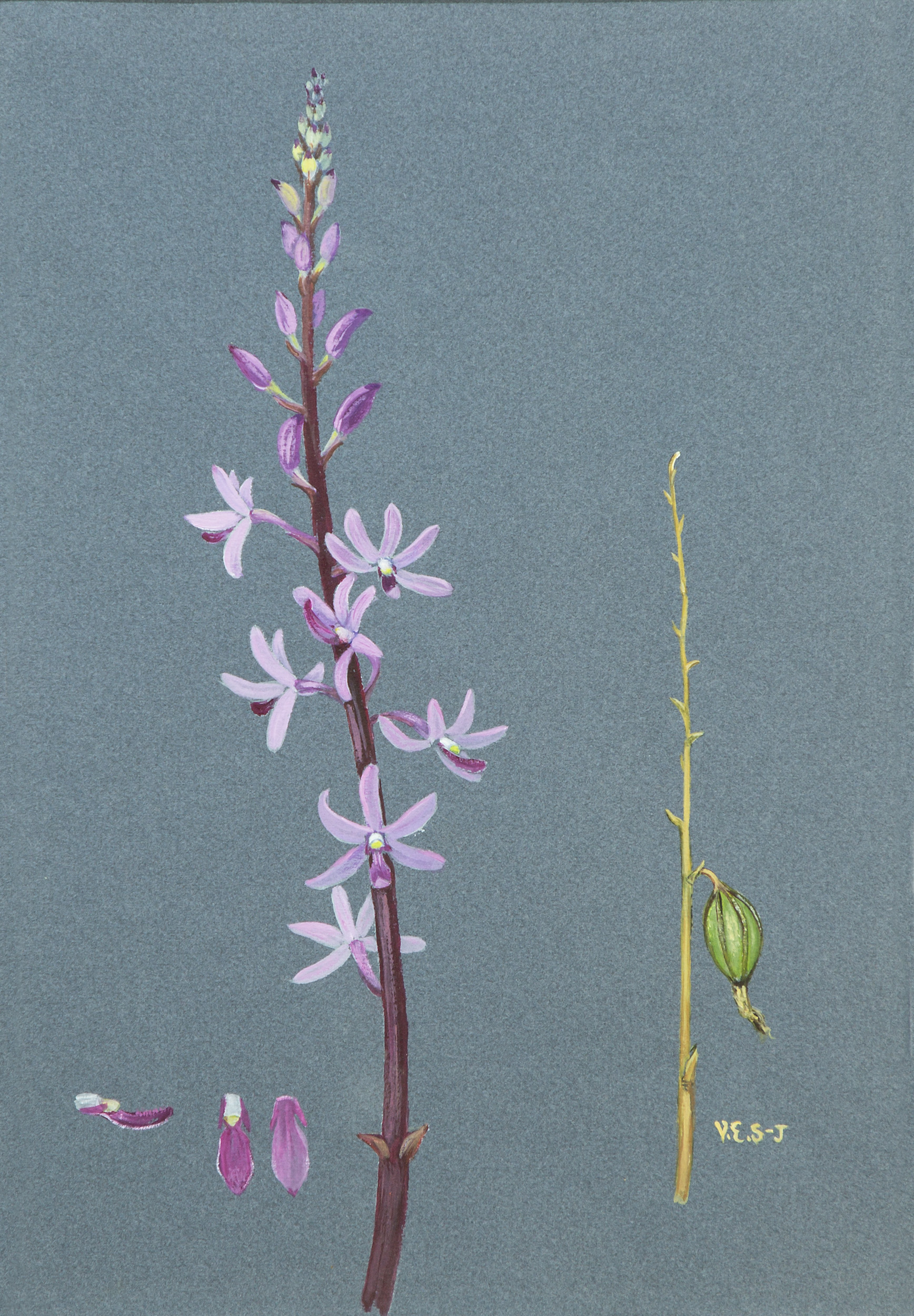
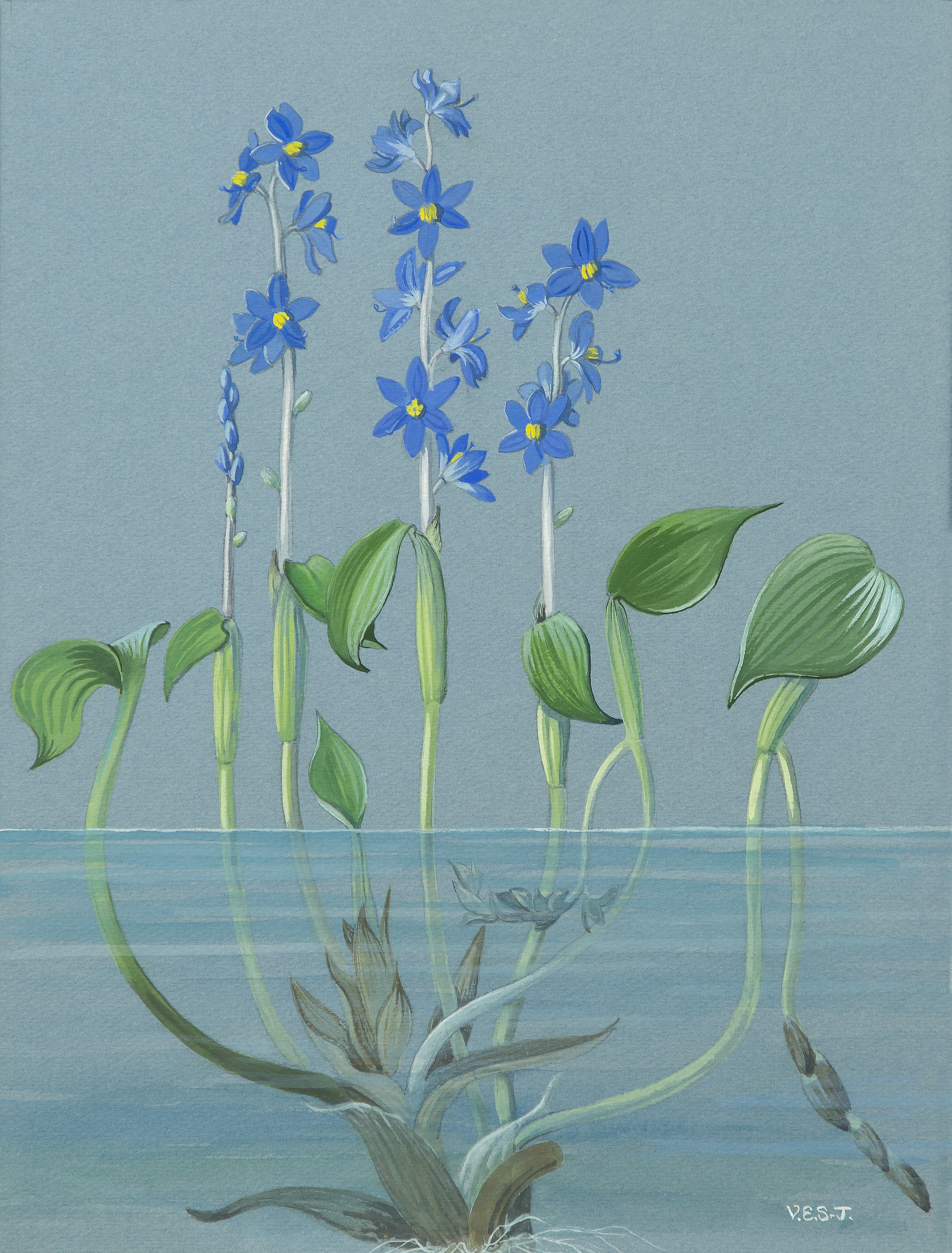

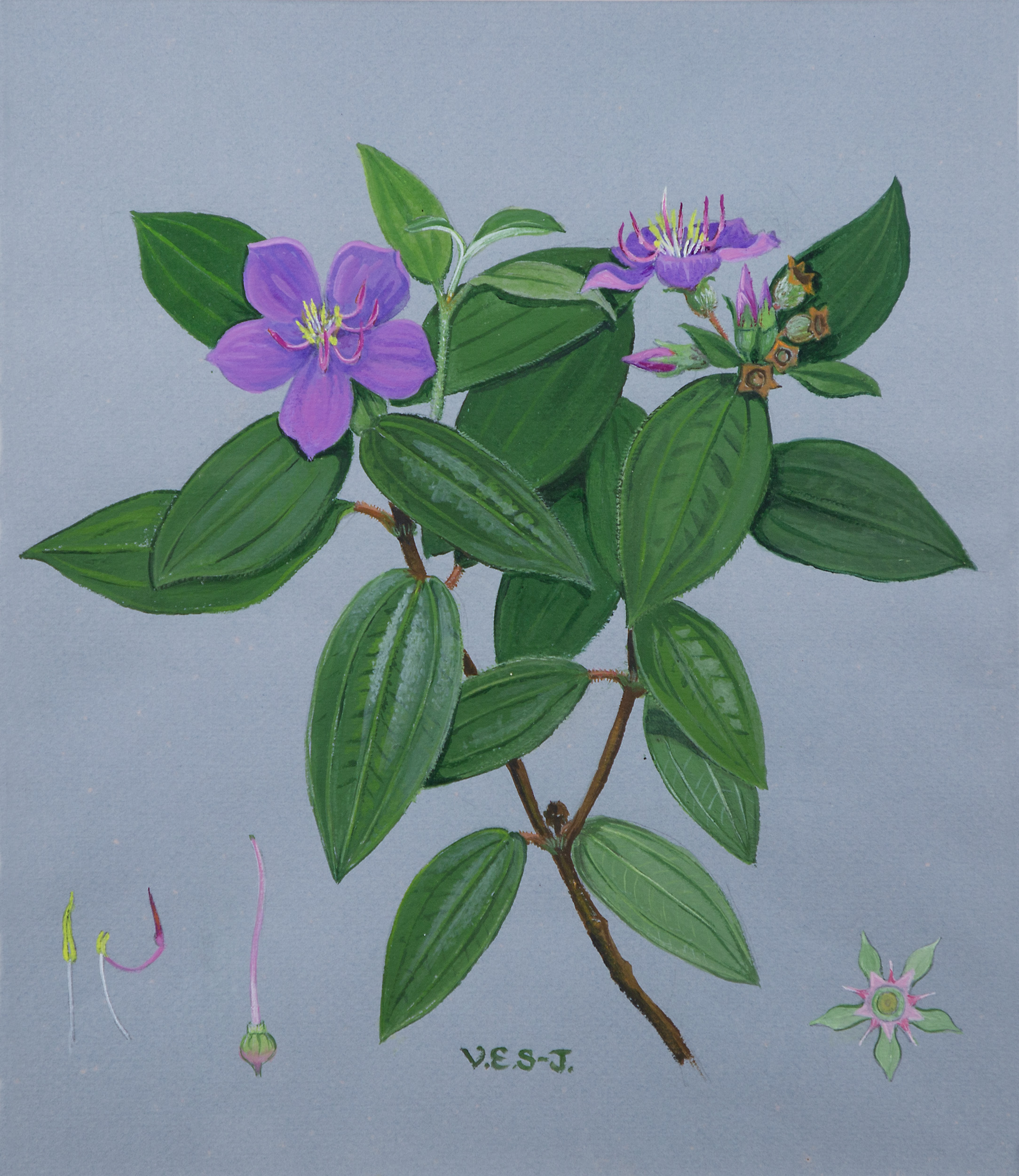
Managing Vera’s gift
Of course, a gift like this needed a suitable home. After the donation, the collection was stored in Cooktown in a small gallery on Furneaux Street and at the Sovereign Hotel until the Vera Scarth Johnson Foundation successfully lobbied for a new building. Since 2000, the collection has been housed at Nature’s Powerhouse, a gallery space and information centre in Cooktown’s Botanic Gardens.
Despite the many advantages of having a dedicated gallery facility, managing a collection of works on paper in a tropical climate, and with an idiosyncratic building, is challenging. Challenging, too, is the retention of an active volunteer workforce with the energy and interest to dedicate to the collection’s ongoing care. Yet for the past 24 years, a variety of dedicated volunteers from the Vera Scarth Johnson Association have been caring for the collection and curating changeover exhibitions.
Preserving Vera’s gift
I began working on the project to review the collection in February, develop a new collection policy and review collection management procedures. To prepare for the onsite assessment of the artworks we created an assessment template and procured a range of materials. Michael and I then headed up to Cooktown and spent a week working on the 154 artworks. We set up temporary workstations in the gallery for the different tasks required, including a makeshift studio so we could take high resolution images of each artwork.

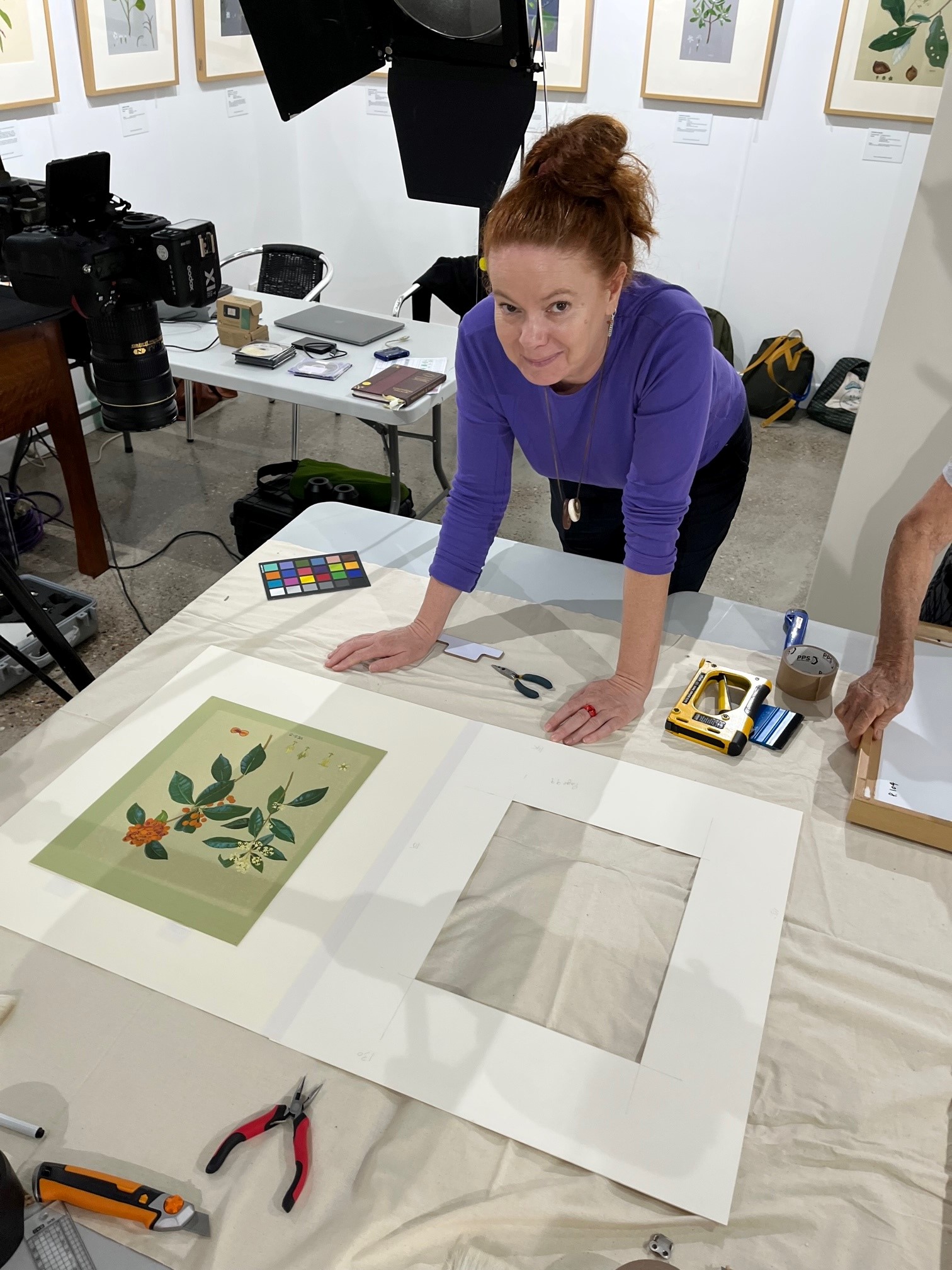
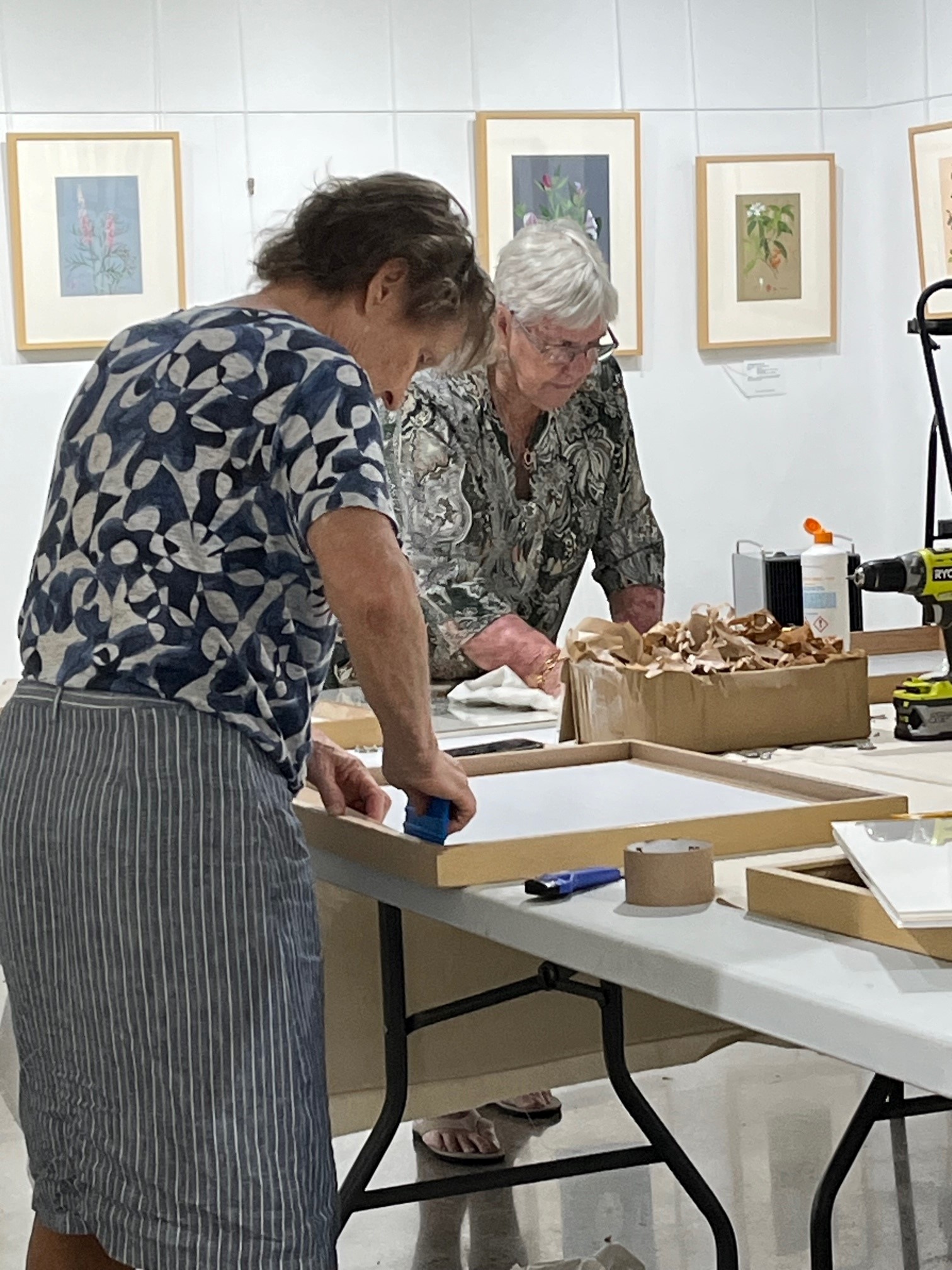


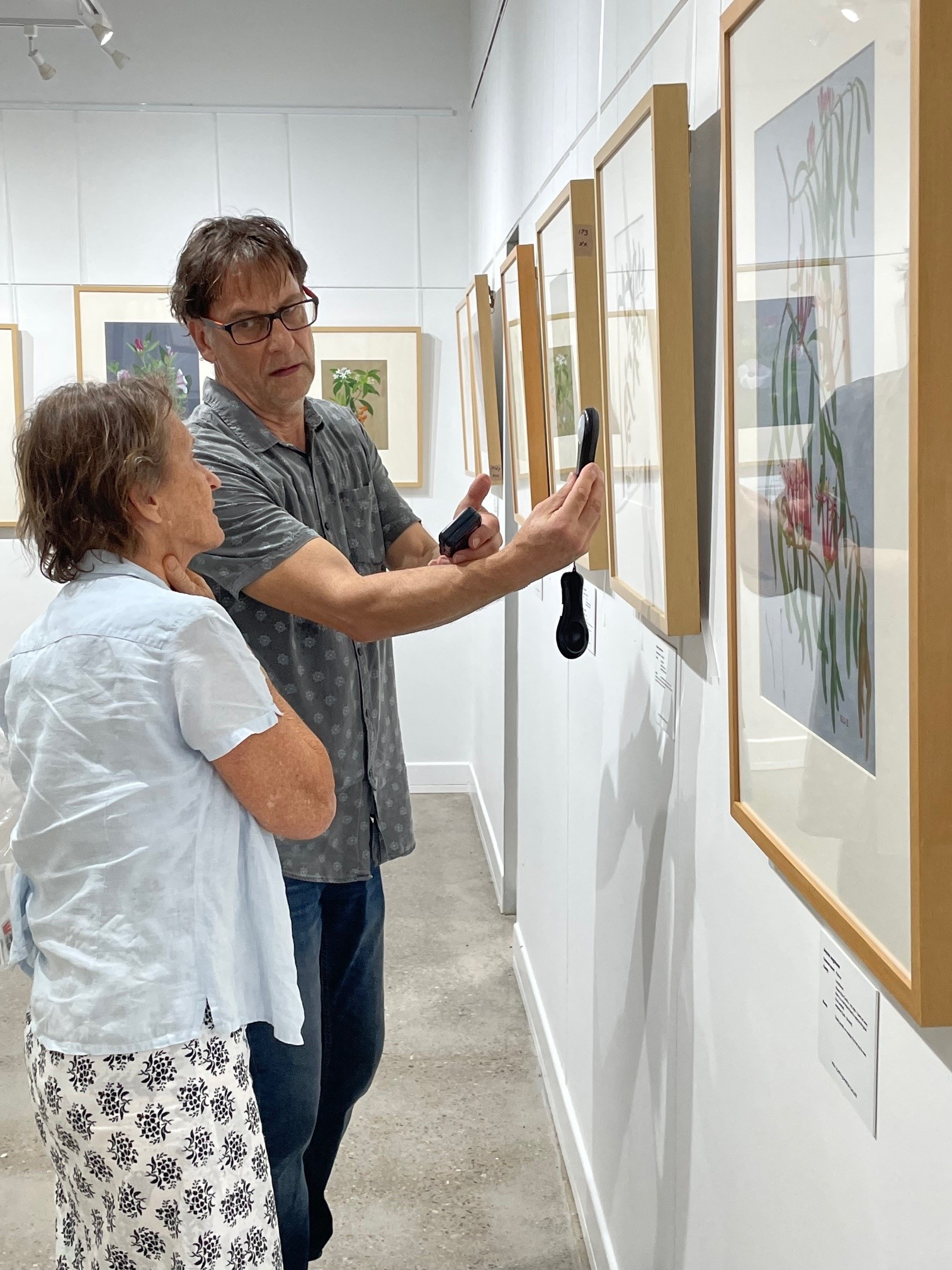
Whilst there, we were privileged to work with some wonderful volunteers, full of knowledge of the region’s natural diversity and of passion for Vera’s work. As we trained them in collection management, dismantling artworks, condition assessments, cleaning and reframing, they taught us about the beauty of species in the paintings and told us stories about their time with Vera when she was still alive. For some of the volunteers, it was the first time they had seen the works outside of the frames and they were excited to see them in more detail.
Vera’s choice of canvas materials reveals much about her process and underscores her belief that she was a botanical illustrator first, artist second. Many of the paintings are on matboard offcuts, or coloured paper torn from a sketch pad. But her pragmatism ended there. Each illustration reveals the how keenly she observed the specimens. The works have a delicacy and tenderness, so much so that it almost feels as though she was painting a love letter to each of the species she was depicting.
I’m excited to start working on the next phase of the project to refresh the gallery space with the Vera Scarth-Johnson Association volunteers over the coming months. Stay tuned for updates about the next phase of the project.
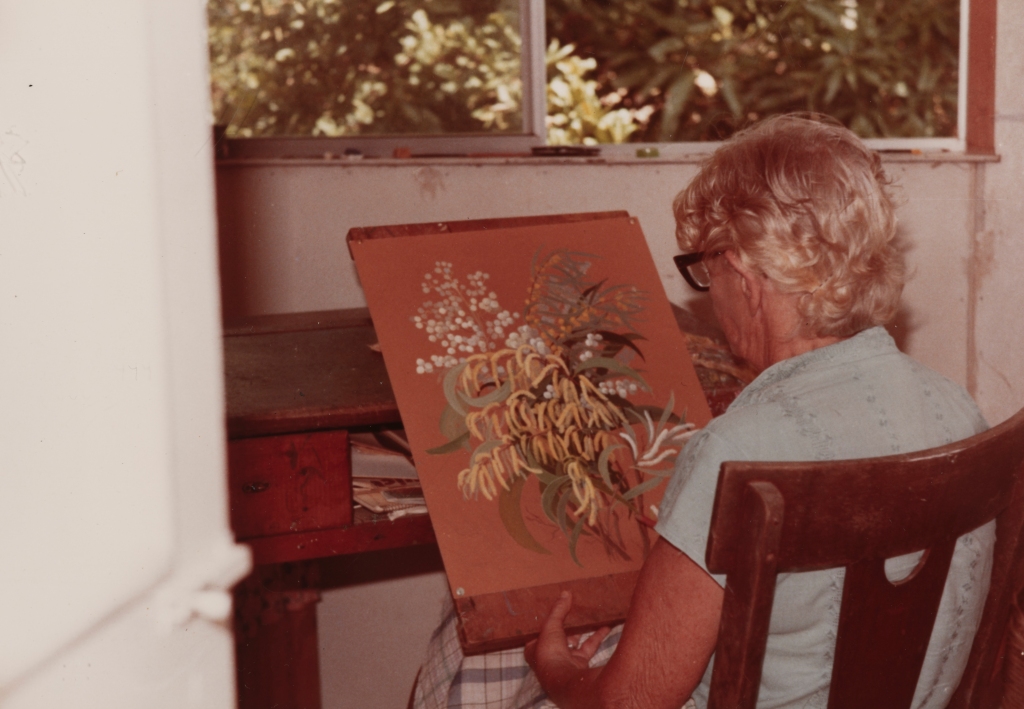
Photo source: Vera Scarth-Johnson Association Archive
Last few months in FNQ
FNQ’s museum community is always a hive of activity … and as the MDO for the region, I can assure you there’s never a dull moment. Over the last three months, I’ve been kept on my toes juggling a few different projects and visiting a number of communities. Here’s a brief snapshot to keep you in the loop:
BACK TO COOKTOWN










It was great to finally get back to Cooktown to catch up with old friends and meet some new faces. Apart from enjoying the region’s culture and history, I also appreciate the drive – up the Byerstown Range, through the Palmer River goldfields, past Black Mountain (Kalkajaka) and over the Annan River (Yuku-Baja-Muliku). First stop was Natures Powerhouse to meet the Vera Scarth Johnson Association committee. The new cast of friendly volunteers were keen to chat about display refreshment and collection challenges. I have to admit to being a little bit in love with Vera’s story so I am always interested to see what this group are up to.
I spent a morning at the Cooktown History Centre with Bev Shay and Marge Scully. They continue to manage a vast collection – but now in a fully airconditioned building! That’s gold… particularly during the summertime. I also got to do some hands-on work and to help Bev refresh displays in the John Hay room. Almost next door is the Waalmbal Birri Heritage and Culture Centre. It was my first time visiting their new building and I was lucky enough to chat with five members of the team, including founders Loretta Sullivan and Alberta Hornsby. Listening to them talk about developing the centre was inspiring – they have a great message to share.
The National Trust of Australia’s (QLD) Cooktown Museum was my final museum stop. The old convent building never fails to stop me in my tracks – it has such presence in the landscape. I met up with site manager, Bev Grant, and staff, chatted about the collection and had a look at the museum’s new interpretation. On the way home, I also stopped at Lakeland to look at the new sculpture park – some great pieces of art made from recycled materials – make sure you stop if you’re driving through!
OUT AND ABOUT: TABLEANDS AND YARRABAH


Driving across the range to Yarrabah Arts Centre is always a treat. This time I was joined by Aven Noah Jnr, curator at Northsite, who was keen to visit the centre with me. Simone Arnol (centre manager) and Bernie Singleton showed us the amazing work being done to upgrade their displays and also discussed their aspirations to enhance the collection management and build skills through training. Great, too, to see the gatehouse building showcasing artworks made on site by Yarrabah’s talented resident artists.


Mareeba Heritage Centre has a new manager, so I thought I’d stop in for a chat. I worked with Sandrine Gloton previously in Croydon – it’s great to have her back in the museum sector. I discovered a few new additions, including their audio tour. I also loved seeing the volunteers in action – juggling an army of school children through different stations at the museum – I’m not sure who was having more fun!
In mid-October 20 people gathered at Atherton’s Old Post Office Gallery for the Tablelands Heritage Network meeting. This is a great group, always keen to learn and share. I ran a significance training workshop first and volunteers then showcased some of the artifacts they had brought along. It was an engaging morning – and highlighted the enduring effectiveness of a good old show and tell session!
Proposed Chinese Culture and Heritage Centre, Cairns


Over the last few months, I’ve been working with exhibition designer and photographer, Michael Marzik, and the team at CADCAI on plans for the proposed Chinese Culture and Heritage Centre. As well as working with architects to determine the layout and fixtures, we’ve visited the Hou Wang Temple in Atherton and the Chinese temple in Innisfail. We are in the process of creating a curatorial concept brief and storage overview with a small volunteer working group. The symbolism and significance of the Lit Sung Goong Collection is mesmerizing, and it’s a such a pleasure to work with and learn from this passionate group of volunteers.
“STRAIT” INSTALLATIONS – ART AWARDS & MURUYGAW NGULAYG / AU LE IRA PADAR EXHIBITION
In July, Ewen McPhee and I travelled up to Thursday Island to run exhibition training workshops with the staff at Gab Titui Cultural Centre and help prepare for the 2023 Gab Titui Art Awards. We used this as a chance to develop an exhibition brief for a new display in the Ephrain Bani gallery (the cultural maintenance gallery). Lead curator, Leitha Assan, went on to develop the exhibition, Muruygaw Ngulayg / Au Le Ira Pardar (Wisdom of Our Elders) and, with her team, coordinate the Art Awards.
Ewen and I returned in October/November to help with the installation of both the exhibition and the awards. We were joined by freelancers Michael Marzik and Aven Noah Jnr. As always, hands on training during the installation made the process fun and engaging. It’s a joy to work with the team at Gab and learn about the culture being maintained and produced by contemporary artists. To cap it off, we got to attend the awards night and see the spectacular dancer team from Erub Island.






Adaptation and collaboration: creating the gallery for “Cooktown’s War”

Cooktown’s War: final exhibition in one of the nun’s cells at James Cook Museum, Cooktown. Photo: Ewen McPhee.
Like many museums across Queensland, James Cook Museum received funding from the Anzac Centenary Local Grants Program. Designed to showcase the museum’s First World War collections, the grant also included time for Ewen and I to provide onsite advice, reconfigure the gallery space and install the exhibition.
When Kate Eastick took over the reins as the museums new curator, however, she decided to refocus the exhibition to tell stories from the home front and the local community, and identified a different space for the exhibition. This change responded, in part, to some of the stories and objects Kate uncovered during her research. An unexpected find, for example, was a hand crocheted square (pictured below). She was also keenly aware of Cooktown History Centre’s Behind the Lines Exhibition, which provides detailed biographies of Cooktown’s soldiers and their wartime experiences.
Cooktown’s War creates an additional narrative layer to Cooktown’s war stories and reveals the impact of the First World War on Cooktown residents. And by working with members of the History Centre, the exhibition demonstrates the benefits of two of Cooktown’s premier collecting organisations pooling resources and knowledge. Shared photos and research have meant that details about rifle clubs, and Chinese business owners and war loans have been placed on display. Difficulties surrounding Indigenous enlistment are explored through archives and portraits of Charles and Norman Baird, brothers who were among Queensland’s Indigenous soldiers from the region. Stories of Red Cross fundraising initiatives and women’s patriotic activities have been woven into the exhibition framework through evocative photographs (see below). Kate also included a contemporary story using a uniform and images from the 100 years commemorative march held in Cooktown this year.
Changes to the project meant that Ewen and I also had to make adjustments. The alternative gallery space meant Ewen had to install a new hanging system and different types of framing mounts and matts were required. By coincidence, Cooktown’s timber honour board, already on the display, is located outside the gallery. This, and a poster created to promote the exhibition, created a nice entry to the gallery. I had to remove some photos and posters from damaged frames for conservation and display purposes. I also made a range of different mounts and object supports, and generally extended my sewing skills! Of course, label making is always a feature for this type of project, but I can advise that the degree of difficulty definitely increases as the temperature and humidity rises!
MDOs have to be fairly versatile and responsive whilst in the field. As James Cook Museum had recently had a serious pest issue in its Indigenous display cabinets, we took time out from the exhibition to reline the cases with unbleached calico and then reinstall all the objects that had been treated prior to our arrival.
Follow up from Cyclone Nathan, FNQ

Preparation for Cyclone Nathan at James Cook Museum, Cooktown, March 2015.
Image: Jacqui Collins-Herrmann, Manager, James Cook Museum.
After two weeks of watching and waiting as Cyclone Nathan carved an erratic path back and forth across the Coral Sea, it finally passed over the FNQ coast on Friday/Saturday between Cape Flattery and Cape Melville. This more northerly crossing meant that the museums in Cooktown were spared the worst of the severe winds, and the museum at Coen did not experience adverse weather. A number of these organisations are housed in heritage buildings. During cyclone season, we always reflect on the vulnerability of these buildings to heavy rain and cyclonic weather, particularly if they have sustained damage from previous weather events.
As usual, MDOs worked with groups in the immediate vicinity pre and post cyclone to discuss their preparations and contingencies, and to offer advice and support. We are pleased to advise that none of the organisations sustained significant damage or impact. Staff and volunteers at James Cook Museum, Nature’s Powerhouse, Cooktown History Centre and Cape York Heritage House all did a fantastic job during the lead up phase to ensure that collections, data and buildings were as prepared and protected as they could be.
Cyclone preparation and clean up can be an exhausting process – at work and at home. And it always disrupts work on other projects. For Cooktown History Centre, Cyclone Nathan meant putting on hold their research and preparations for the new exhibition they plan to open for Anzac Day. Spare a thought for these groups now as they clean up, reopen and get back to the business (and pleasure) of running museums.
MDO’s in Coen post Cyclone Ita
Almost a month after Cyclone Ita threatened communities along the Far North Queensland coast, it is great to see museums in the Cook Shire back in business and getting ready for the tourist season. The museums and collecting groups in the region did a great job with their disaster preparedness – it’s fortunate that the predicted impact did not eventuate for these organisations. After being in close contact with the groups during the lead up to the cyclone, it was great for the MDOs for Far North Queensland and North Queensland to travel to the region and undertake some practical work with communities.
Last week, Jo Wills and Ewen McPhee traveled up the Peninsula Development Road to Coen to work with Gail and Peter Clark at Cape York Heritage House. There is always something to see and enjoy while traveling through this magnificent country – this time there was much more water around, and small billabongs and water lilies were evident along the roadside. It was also good to see that heritage places like the Musgrave Telegraph Station were still standing strong. Unfortunately, as the road through Lakeland National Park was closed we couldn’t visit Old Laura Homestead to see how that had fared.
Jo and Ewen have worked at Cape York Heritage House in Coen for the last three years, each time helping the local volunteers to clean, refresh, reinvigorate and reinstall displays. Every year, the volunteers pack down the museum for the wet season and reinstall at the beginning of May. In addition to the usual work, this year the MDO’s helped Gail begin work on a new policing display, put up some information about WWI, cleaned up the mining machinery display and developed plans for future projects in the region.
After three days in Coen, the MDOs headed back to Cooktown to James Cook Museum and Nature’s Powerhouse. Although cyclone damage is a little more evident there, again it is nowhere near the predicted impact.
Stay tuned for more entries about the MDO’s recent activities in Cooktown.
beautiful cases
Timber display cabinets that once housed Queensland Museum’s collections in Brisbane have been unearthing themselves in museums throughout the State. Mary Kathleen Park in Cloncurry and James Cook Museum in Cooktown have both been visited recently by Cairns based MDO, Jo Wills, and Townsville based Ewen McPhee where they came accross the cases. Further enquiries also found them in Kingaroy at the Kingaroy Heritage Museum. All of the cases appear to be in good condition, and most are intact with early glass and are being used as intended – to display the State’s moveable cultural heritage. They are also a collection object in themselves.
The cases came from the Old Queensland Museum in Brisbane when it was located in the Brisbane Exhibition Hall from 1899. Queensland Museum remained in this building until 1986 when a new Queensland Cultural Centre was constructed. In fact the cases may be even older than the Exhibition Hall phase as there were earlier buildings that were also used by Queensland Museum. For a history on other buildings used by the Queensland Museum have a look at this blog here.
Please leave a comment or get in touch if you know any more about the history of these display cases or if your local museum or collecting place has some as well.
















